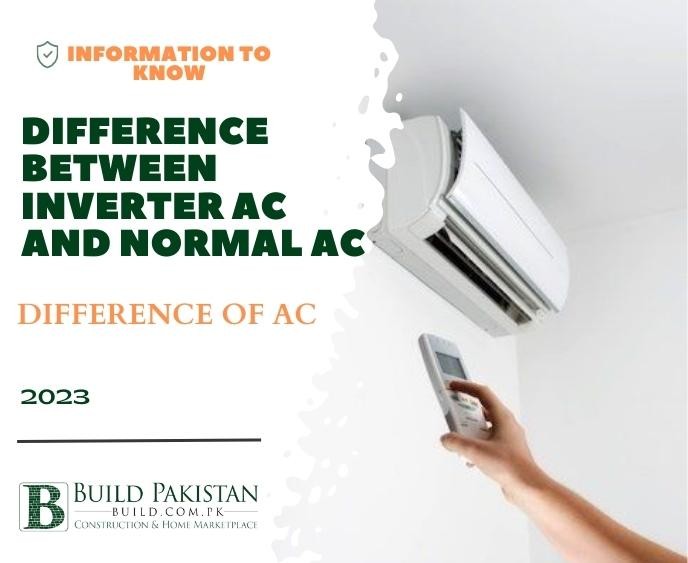Difference between Inverter AC and Normal AC

Introduction:
In Pakistan, summers may be very severe, especially for
residents in the South, where temperatures can soar between May and August. As
might be expected, customers buy air conditioners (ACs) in great numbers during
these few months to escape the heat. Yet, despite the fact that air
conditioning has rapidly replaced being seen as a luxury in the majority of
Pakistani towns, many people are still not aware of the distinctions between an
inverter AC and a standard AC. In reality, when it comes to the argument
between inverter AC and standard AC, the majority of them choose to pick the
less costly alternative without considering the finer points.
Now that summer has officially here, it's time to learn the
distinctions between these two types of air conditioners, which are frequently
used in both home and commercial settings. In addition, we'll also address some
of your most important queries, such as What is an Inverter AC? What is the
electrical consumption of an inverter air conditioner? Does buying the inverter
AC make sense? And more importantly, which of these will contribute to a
reduction in your energy costs?

THE PRINCIPLES DIFFER FROM NORMAL AC AND INVERTER AC
There are several differences between these two ACs despite
the fact that they may appear to be identical. Below are the primary contrasts
between split and inverter air conditioners.
EFFICIENCY OF COMPRESSOR USE AND OPERATION:
One of the most significant distinctions between inverter and non-inverter air conditioners is this.
The compressor in most split air conditioners can only operate in two modes: on and off. It operates at a predetermined pace until the room reaches the proper temperature, at which point it turns off before restarting and performing its intended purpose as soon as the room warms up. If your standard AC is set to 26 degrees Celsius, for instance, the compressor will turn off when the room reaches that temperature. The compressor will restart after the room starts to warm up, which may only take a few minutes, and the temperature reaches 28 degrees Celsius.
On the other hand, the compressor's cooling capacity is
efficiently controlled by its variable speed operation. Instead of shutting off
when the temperature is achieved, the compressor regulates itself to operate
slower at first and then faster as the room warms up. If an inverter air
conditioner is set at 26 degrees Celsius, for instance, the compressor will
slow down after the target temperature is reached and will gradually raise its
speed if the room temperature rises by even one degree.
BEING ENERGY CONSUMER
Another contentious topic is the power consumption of inverters versus traditional AC. You would assume the inverter air conditioner would use more energy because its compressor operates continuously while the compressor in a typical air conditioner stops and begins very frequently. But that's not accurate.
Since they automate the cooling process and change the power usage as necessary, inverter air conditioners actually consume less energy than conventional air conditioners. On the other hand, non-inverter ACs compressors operate in a fixed manner. It only operates at full power or no power, therefore it uses a lot of energy. Also, it takes a lot of energy for the compressor motor in standard ACs to restart.
NOISE
Have you ever observed that some air conditioners' exterior units generate a lot of noise while others don't? Compared to inverter ACs, the exterior units of non-inverter air conditioners make a lot more noise. The explanation is rather straightforward: whereas the motor in an inverter air conditioner runs at varied speeds during operation and makes no noise, the compressor motor in conventional air conditioners automatically turns on and off.
COST
Due to their use of cutting-edge technologies like
energy-efficient compressors and sophisticated sensors, inverter air
conditioners are often more expensive to purchase than conventional ones. The
main distinction between inverter AC and traditional AC is this. Inverter air
conditioners may lower your power usage and, as a result, your electricity
bill, making them a long-term investment even if they are more expensive.
It is also crucial to note that while standard air conditioners are slightly less expensive, their maintenance costs are greater because of the general wear and tear brought on by the compressor motor's frequent rapid-fire shut-off and restarts. This implies that inverter air conditioners have a longer lifespan than standard ones.
ENVIRONMENTAL IMPACT
The relative effects of inverter and non-inverter air
conditioning on the environment are another significant distinction.
Refrigerants, a material that transforms from gas to liquid to enable cooling and decrease the temperature to the required level, are used by all air conditioning machines. The majority of non-inverter air conditioners utilize R-22 refrigerant, which includes the dangerous for the ozone layer chemical hydrochlorofluorocarbon (HCFC). As it is less expensive, many people utilise it. As inverter air conditioners often use next-generation refrigerants like R-410A or R-32, they are fairly eco-friendly. These refrigerants are not only more energy-efficient but also better for the environment.










